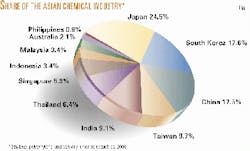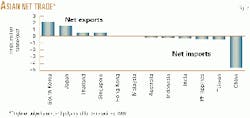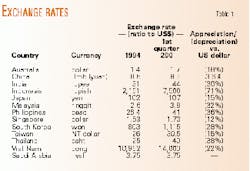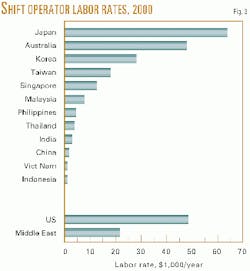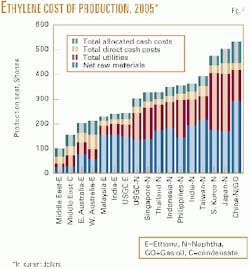Many issues account for widely varying capital and manufacturing costs among Asian petrochemical producers.
Issues that impact a country's cost competitiveness include government policy, exchange rates, interest rates, tariffs, capital costs, variable costs, and fixed costs.
Chem Systems recently completed a study of manufacturing costs of world scale petrochemical plants to examine Asia's cost competitiveness today and in 2005.
Asia's rebound from its 1998 financial crisis, fueled by increasing exports among strong economies in the rest of the world, occurred more quickly than anticipated.
While Asian currencies remained weak during 2000, interest rates declined and consumer demand increased. Considerable progress has been made in restructuring banking systems and refinancing private company debt although there is still much to do in reducing nonperforming loans.
As shown in Fig. 1, most countries in Asia are active participants in the petrochemical industry. North Asian countries (Japan, South Korea, China, and Taiwan) dominate; they have about 70% of installed capacity (industry size for each country has been approximated by combining capacities for ethylene, polyethylene, and polyvinyl chloride).
Fig. 2 shows that intra-regional trade is an important characteristic of the Asian region. South Korea, Japan, Thailand, and Singapore have surplus capacities. China by far is the primary importer of basic petrochemicals for the region.
For comparison with the Asian economics, the analysis presents production economics for similar facilities at the US Gulf Coast and Middle East.
Project costs
Petrochemical project costs largely depend on currency, labor, and capital costs and are usually denominated in dollars to limit the overall impact of currency changes.
Chem Systems surveyed contractors and manufacturing companies to develop estimated production costs in the form of location factors for a large pro forma grassroots chemical plant built at a partly developed site.
Wide variations in construction costs exist within each country because no two existing plants or locations are exactly alike. Furthermore, plants are built at different times and reflect contractors and equipment manufacturers' competitive situations.
Table 1 lists how currencies of various Asian countries have fared since 1994. Only China's currency has increased in value relative to that of the US. For a number of Asian countries, actual exchange rates continued to weaken after the first quarter of 2000.
Most currencies in Asia have depreciated sharply vs. the US dollar from precrisis levels. In the extreme case, the Indonesian rupiah lost 70% of its value between 1994 and 2000. With the exceptions of China and Japan, the typical loss has been in the range of 20-40%.
The loss of currency value has slightly increased the competitiveness of some Asian countries by reducing labor expenses. Labor accounts for 30% of the cost of building a plant.
Construction projects often use lower-cost workers from countries with low wage rates, such as India and Indonesia. On the other hand, very high-cost, skilled workers and managers from the west are also needed to varying degrees. The relative labor cost for construction must consider all of these factors.
Labor rates for plant operators vary substantially in the Asian region. Costs start from more than $50,000/year in Japan to less than $1,000/year in Indonesia and Viet Nam. By comparison, the US labor rate is $38,100/year (Fig. 3).
Partly compensating for these cost differences between countries is lower labor productivity, which results in higher average staffing levels. For example, it takes more than twice the number of people to run a plant in China than to run one in the US. On the other hand, Japanese staffing is about 90% of US staffing.
On average, staffing in South Asian plants is about 30% greater than that in US plants.
Key elements to building a petrochemical plant include materials, construction, and engineering.
Materials capital costs include equipment, piping, electrical supplies, and instruments. Differences occur depending on whether the materials are supplied locally or imported, the likely source of imports, and whether duties are paid on imports.
Construction costs include those for civil requirements, buildings, steelwork, mechanical needs, pipes, insulation, painting, electrical supplies, and instruments. Engineering and construction costs reflect relative salary costs, country-specific productivity levels, and the mix of domestic and imported staffing.
Ethylene production costs
Each Asian country's costs and competitive position for ethylene production is unique. Although currency and labor costs affect production costs, raw material costs and utilities are also big factors.
Fig. 4 breaks down ethylene manufacturing costs in East Asia in 2005. This figure includes several speculative plants that are expected to be operational by 2005, including ethane crackers in Western Australia and India and a naphtha cracker in the Philippines.
Cash costs for ethylene production (including US and Middle East plants) range from $100/tonne to more than $500/tonne, demonstrating the very wide range of costs that exist within the region. Middle East plants employing ethane and condensate feeds are the overall low-cost producers.
As shown in Fig. 4, ethylene production costs can be split into three distinct groups, divided by costs.
The lowest-cost producers are essentially all based on ethane feedstock. The low-cost Asian producers are the ethane crackers of Malaysia, Australia, and India at cash costs of about $200-$240/tonne. Their costs are still higher, however, than those of the Middle East plants ($100-150/ton).
Production costs of the US Gulf Coast (USGC) ethane crackers are also quite competitive, reflecting a forecast return to the more typical lower USGC feedstock prices than existed during much of 2000.
The middle group of producers have similar total cash costs between $350 and $430/tonne. These include mostly naphtha fed steam crackers, such as those in Thailand, Taiwan, Singapore, Indonesia and India. Production costs for USGC naphtha-based crackers, at about $300/tonne, are expected to be somewhat lower than this range, reflecting the benefits of worldscale capacity, technology, and strong by-product credits. The third group shows a relatively high cost of production (about $550/tonne) and consists of crackers in China, South Korea, and Japan.
High costs for this group are driven by high feedstock and utility costs, which in turn reflect the high cost of fuel in North Asia. Relative to Japan and South Korea, China has high net feedstock costs, reflecting lower byproduct credits.
On average, ethane-based crackers have superior economics compared to liquid feedstocks.
The Middle East production centers, reflecting very competitive pricing for feedstocks and the benefits of worldscale plant capacity and technology, will remain low-cost producers. These advantages will be offset, however, by the higher cost to deliver their production to consuming markets in Asia and Europe.
Producers in North Asia, as a result of logistical and other considerations, have relatively high-cost positions. Both South Korea and Japan are major exporters of petrochemical derivatives, however, and effectively must price derivative exports below the cash cost of production to compete with other producers.
Bruce F. Burke is director of the energy and refining practice of Chem Systems, a wholly owned IBM company. He leads energy-related consulting assignments in North America, South America, and Asia. His areas of interest include natural gas utilization, refinery planning and strategic analysis, refining/petrochemical interface optimization, project feasibility and financing, lubricants, and market and profitability forecasting. Prior to joining Chem Systems in 1980, Burke worked for Gulf Oil, where he gained experience in process evaluation, product blending and shipping, plant operations, and capital budgetingin refinery operations. Burke holds a BS in chemical engineering from the University of Pennsylvania, Philadelphia.